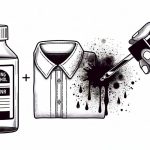If you’ve ever accidentally spilled Aquaphor on your clothes, you know how frustrating it can be to get out. But don’t worry, with a little bit of effort and the right techniques, you can easily remove this stubborn ointment from your clothing.
The key to removing Aquaphor from clothes is to act fast and remove as much of the excess ointment as possible before it sets into the fabric. Once you’ve done that, there are several methods you can use to effectively remove the stain.
From dish soap to vinegar to rubbing alcohol, we’ll cover all the best tips and tricks for getting Aquaphor out of your clothes in this article.
Table of Contents
Act Fast and Remove Excess Aquaphor
You gotta act fast and get rid of any excess Aquaphor before it sets in your clothes. The first step is to scrape off as much of the excess as possible. You can use a spoon, butter knife, or a credit card to gently scrape off the excess Aquaphor from the fabric. Be careful not to rub the Aquaphor further into the fabric.
Next, you need to blot the area with a clean cloth or paper towel. Press the cloth or paper towel onto the area of the stain and lift it up. Repeat this process until you can no longer see any of the Aquaphor on the cloth.
If the Aquaphor has already set in, it might be necessary to use a stain remover. If the stain remover is necessary, make sure to read the label and follow the instructions carefully. Apply the stain remover to the affected area and let it sit for the recommended amount of time.
Rinse the area with cold water and check to see if the stain has been removed. If it hasn’t, repeat the process until the stain is gone. Remember, it’s important to act fast when trying to remove Aquaphor from clothes.
Apply Dish Soap
Now that you’ve removed excess Aquaphor from your clothes, it’s time to tackle the stain itself.
The first step is to pre-treat the stained area with dish soap. Apply a small amount directly onto the stain and gently rub it in.
Next, run the garment under hot water to help loosen the stain. Rinse and repeat the process until the stain has disappeared or significantly lightened.
Pre-treat the Stain
First, grab some dish soap and apply it directly to the affected area to begin pre-treating the stubborn Aquaphor stain on your clothes. Use a small amount of dish soap and gently rub it into the stain with your fingers. This will help to break down the oils in the Aquaphor and make it easier to remove.
After you’ve applied the dish soap, let it sit on the stain for a few minutes. This will give the soap time to penetrate the fabric and loosen the stain. Then, rinse the area with cold water to remove the soap and any loosened residue.
If the stain is still visible, repeat the pre-treatment process until the stain is completely removed.
Use Hot Water
Using hot water is an effective method for removing stubborn stains from your clothing, especially when dealing with oily substances like Aquaphor. First, you will want to turn your garment inside out, exposing the stain directly to the hot water. Fill a basin or sink with hot water that is around 120 to 140 degrees Fahrenheit. Place the stained area of your clothing into the basin and let it soak for about 10 minutes. This will help to loosen up the stain and make it easier to remove.
After the 10 minutes are up, remove the clothing from the hot water and gently rub the stained area with a bit of laundry detergent. You can use a soft-bristled brush or your fingers to help work the detergent into the fibers of the fabric. Once you have thoroughly scrubbed the stain, rinse it out with hot water. If the stain is still visible, repeat the soaking and scrubbing process until it is completely gone. Use the table below as a guide to help you through the process of removing Aquaphor stains using hot water.
| Step | Action | Details |
|---|---|---|
| 1 | Turn clothing inside out | Expose stained area directly to hot water |
| 2 | Soak in hot water | Use water that is 120-140 degrees Fahrenheit |
| 3 | Rub with laundry detergent | Use a soft-bristled brush or fingers |
| 4 | Rinse with hot water | Repeat soaking and scrubbing if necessary |
Rinse and Repeat
After repeating the soaking and scrubbing process, continue to rinse the stained area with hot water until the detergent and Aquaphor residue have been completely washed away. Make sure to use hot water again to effectively remove any remaining residue from the fabric. The hot water helps break down the oils in the Aquaphor, making it easier to remove from the clothing.
While rinsing the stained area, use your fingers to gently rub the fabric to ensure that all the residue is being removed. If the stain remains, repeat the soaking and scrubbing process once more, and then rinse the area again.
It may take a few cycles of soaking, scrubbing, and rinsing to completely remove the Aquaphor from the fabric, so be patient and don’t give up. With persistence, you can successfully get the Aquaphor out of your clothes and prevent a stubborn stain.
Use Vinegar
To tackle the Aquaphor stain on your clothes, simply mix white vinegar and water in a bowl and apply it directly to the affected area. This solution is a great way to break down the greasy residue of Aquaphor and lift it from the fabric.
Here’s how you can use vinegar to get rid of Aquaphor stains:
- Mix equal parts of white vinegar and water in a bowl.
- Dip a clean cloth in the solution and wring out the excess liquid.
- Apply the damp cloth directly to the stained area and gently rub in a circular motion. Repeat until the stain is lifted.
Be sure to rinse the stained area with clean water after applying vinegar to remove any lingering smell.
This method is effective in removing Aquaphor stains from most types of fabric, but it’s always best to test the solution on a small, inconspicuous spot first before applying it to the entire stain. With a little bit of patience and elbow grease, your clothes will be looking as good as new in no time!
Try Rubbing Alcohol
If you’re looking for a quick solution to remove those pesky Aquaphor stains from your garments, rubbing alcohol could be your new best friend. Rubbing alcohol is a common household item that can be easily found in most stores. It is a great option for removing oil-based stains like Aquaphor from clothing. However, before using rubbing alcohol, make sure to test it on a small, inconspicuous area of your garment to ensure that it doesn’t damage the fabric.
To use rubbing alcohol to remove Aquaphor from clothes, follow these simple steps:
| Step | Instructions |
|---|---|
| 1 | Blot the stain with a clean, white cloth to remove as much of the Aquaphor as possible. |
| 2 | Pour a small amount of rubbing alcohol onto a clean cloth or cotton ball. |
| 3 | Dab the rubbing alcohol onto the stain, working from the outside in. |
| 4 | Allow the rubbing alcohol to sit for a few minutes, then rinse the area with cold water. |
| 5 | Repeat the process until the stain is completely removed. |
Rubbing alcohol can be an effective solution for removing Aquaphor stains from clothes, but it’s important to remember that it may not work for all types of fabrics. If the stain persists after using rubbing alcohol, it may be best to seek professional cleaning services or consult the garment’s care label for further instructions. With a little patience and persistence, you can say goodbye to those stubborn Aquaphor stains and keep your clothes looking their best.
Avoid Heat
Steer clear of any heat sources when dealing with Aquaphor stains on your garments, as heat can set the stain and make it even more difficult to remove. Here are four reasons why avoiding heat is crucial when trying to get Aquaphor out of clothes:
-
Heat can cause the Aquaphor to melt and spread even further into the fabric fibers, making it much harder to remove from the clothing.
-
Applying heat to the stain can also cause it to become more deeply ingrained into the fibers of the garment, which can lead to permanent discoloration.
-
Using hot water or a dryer to try to remove the stain can cause the Aquaphor to solidify and become even more difficult to remove.
-
Heat can also cause the Aquaphor to bond with the fabric so tightly that it can never be fully removed from the garment, leaving a permanent stain.
To avoid any of these problems, it’s best to avoid heat altogether when trying to get Aquaphor out of your clothes. Instead, try using rubbing alcohol or a pre-treatment stain remover to break up the stain and loosen its grip on the fabric. Then, wash the garment in cold water and hang it up to air dry.
With a little patience and persistence, you can easily get Aquaphor stains out of your clothes without causing any damage to the fabric.
Repeat if Necessary
When dealing with aquaphor stains, it’s important to inspect the affected area for any residual product. If there is still some left, don’t fret – there are alternative methods you can try to remove it.
The key to successful stain removal is persistence, so don’t give up if your first attempt doesn’t work.
Inspect Stain for Residual Aquaphor
Upon inspection of the stain, you’ll likely find residual Aquaphor that needs to be treated before washing the garment. Even if you think you’ve removed all of the petroleum-based ointment, there may still be a thin layer left on the fabric.
This can cause the stain to reappear after washing and drying, so it’s important to take a closer look before moving on. To check for residual Aquaphor, hold the garment up to the light and look for any shiny or oily spots. You may also feel a greasy texture when you touch the affected area.
If you do notice any leftover ointment, apply a small amount of dish soap or laundry detergent directly to the stain and gently rub it in with your fingers. Let the detergent sit on the fabric for a few minutes before washing the garment as usual.
Try Alternative Methods
If you’re feeling frustrated with traditional stain-removal methods, it’s time to try out some alternative options. One great method to try is using rubbing alcohol or nail polish remover. Simply dampen a cotton ball with either substance and gently blot at the stain.
Make sure to test a small, inconspicuous area of the fabric first to ensure that the alcohol or remover won’t damage the material. Once you’ve removed as much of the stain as possible, wash the garment in the washing machine on a cold cycle with your usual laundry detergent.
Another alternative method to try is using dish soap. Apply a small amount of dish soap directly to the stain and gently rub it in with your fingers. Let it sit for 10-15 minutes before washing the garment in the washing machine on a cold cycle.
This method may take a few tries to completely remove the stain, so be patient and repeat the process if necessary. With a little bit of effort and experimentation, you can get that pesky aquaphor stain out of your clothes and get back to wearing them with confidence.
Be Persistent
To persist in removing the stain, you’ll need to try a variety of methods and be patient with the process. Sometimes, it can take multiple attempts to completely remove the aquaphor from your clothes. Don’t give up after one try!
One method you can try is using a stain remover specifically designed for oily stains. Apply the stain remover to the affected area and let it sit for at least 5 minutes before washing the garment. If the stain is still there after one wash, repeat the process until the stain is gone.
Another method is using a mixture of dish soap and hot water. Apply the mixture to the stain and let it sit for at least 30 minutes before washing the garment. Be sure to rinse the garment thoroughly after washing to ensure all the soap is removed.
With persistence and determination, you can successfully remove aquaphor stains from your clothes.
Prevent Future Stains
One way you can make sure you don’t get Aquaphor stains on your clothes again is by applying it after you’ve already gotten dressed. This simple solution can save you from having to deal with stubborn stains in the future.
Additionally, it’s important to be mindful of how much Aquaphor you use and where you apply it, as excess product can easily transfer onto your clothing.
Another helpful tip is to use a protective layer between your skin and your clothing. For example, you can wear a robe or a towel around your shoulders while applying Aquaphor to your face or body. This will not only prevent the product from getting on your clothes, but it will also make the application process easier and less messy.
Lastly, consider using alternative products that won’t stain your clothes. There are many other moisturizers and lotions on the market that provide similar benefits to Aquaphor without leaving behind oily residue.
By making small changes to your routine and being mindful of the products you use, you can prevent future stains and keep your clothes looking their best.
- The Top 5 Uses for Nonwoven Fabric You Didn’t Know About - July 11, 2025
- What Makes Nonwoven Fabric So Cost-Effective? - July 11, 2025
- Nonwoven Vs Woven Bags: an In-Depth Comparison - July 11, 2025




